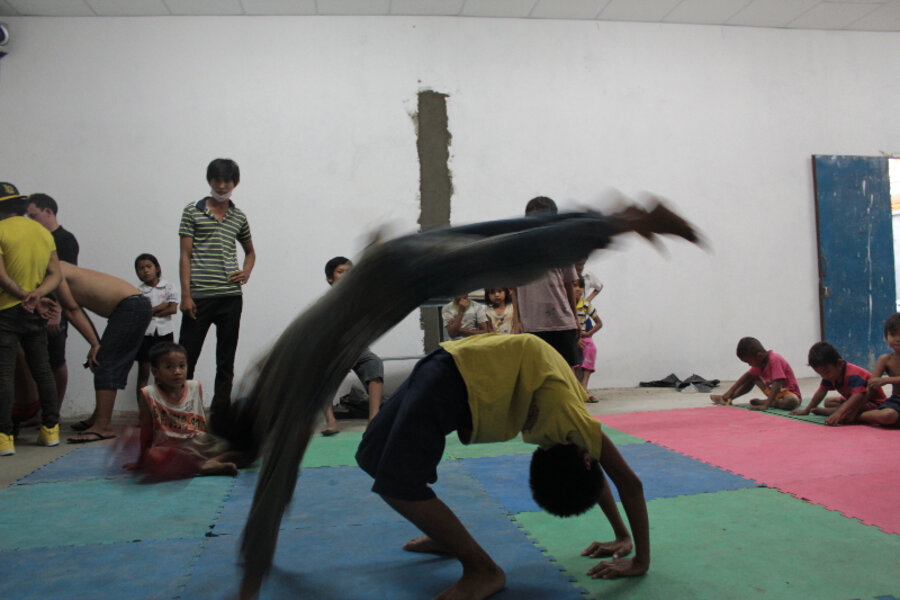In Cambodia, kids breakdance toward better futures
Loading...
Every morning in Phnom Penh, Cambodia, one van and two tuk-tuks ply the broiling streets like American school buses, picking up children and ferrying them through the city’s crush to school.
Except this is no ordinary school. This is breakdancing school.
Tiny Toones, a breakdancing outreach program for Cambodian children, was established in 2007, and its founder, breakdancer Tuy Sobil, is something of a success story himself. At the time Sobil, or KK, was born – in a Thai refugee camp in 1977 – Cambodia had folded into itself as the Khmer Rouge rolled the country back to “Year Zero” in a genocidal campaign that would kill about one-fifth of its population.
KK moved with his family to the Long Beach, Calif., when he was less than a year old, and he grew up performing in California’s breakdancing or "b-boy" groups. But he also joined the Crips gang there, and in 2004 he was convicted of armed robbery and deported to Cambodia under a law that mandates deportation for non-US citizens convicted of felonies. He had never seen Cambodia before.
In unfamiliar Phnom Penh, KK, a lithe and tattooed man, accidently accumulated around him a group of kids who wanted to be like him, to dance like an American b-boy could. He gave them free breakdancing lessons in his apartment and called them “Tiny Toones,” for the baggy clothes that hung off their little bodies and made them look like cartoon imitations of an American street dancer. He soon had some 70 Cambodian children in his home each afternoon. It was time to create a formal school.
And so with funding from aid groups like Bridges across Borders, KK opened a Phnom Penh school that would teach breakdancing as an alternative to gang-life and drug use, problems that plauge this corridor of the city’s capital, where gangs are appealing options for children who feel that they have no options.
“Tiny Toones means everything to me,” KK says. “It's my life, and I want the kids to succeed.”
Most of the 200 or so children enrolled in Tiny Toones are from southeast Phnom Penh’s Chba Ampov neighborhood, a troubled corridor of the city where children collect recyclables to sell for pocket change. Sometimes they are enrolled in public school, other times not. When they become teenagers, little gets better. Drugs in Cambodia are cheap and often billed not as addictive and destructive but as potent energy supplements. Gangs beckon poor kids into their ranks. And so this becomes a place that no one ever leaves.
That’s where Tiny Toones comes in: as a safe, drug-free environment that its founders hope will introduce its students to all their options.
Tiny Toones, housed in a one-story building decorated with sprawling graffiti, is largely a creative program. Students there, aged 5-24, take breakdancing dance classes, as well as workshops in voice and music video production. But the founders have also incorporated a formal education sector into the program to both supplement the public school program and serve students who have left school. Classes in Khmer, English, and computer skills are now among those that all students take.
Some of the program’s participants go on to become dancers, even local Cambodian stars; nine of the school’s 12 teachers are its former students. In rare cases, students go on to higher education. Five former Tiny Toones dancers are now enrolled in universities in Phnom Penh, funded with Tiny Toones scholarships that rely on some corporate or NGO backing but largely on private donations.
“When you consider their backgrounds, that’s just really incredible,” says David Hewitt, Tiny Toones’ press coordinator.
Mostly, though, the program’s successes are subtler.
“The main success for me is not necessarily what they do afterward, but that they’ve built their capacity, their confidence,” says Reuth Chhoeung, or Shhort, the general manager of the program. “We want to let them know that there are other options out there for them.”
That knowledge is particularly important for the girls in the program. At first, girls there were few in number; parents were reluctant to send their daughters too far away from home, let alone to a program that taught not traditional, gentle Apsara dance but an imported, aggressive style.
“For girls, it lets them know that they can do what boys can do,” says Shhort. “They can be more than just housewives.”
This year, about half of the program’s participants are young women, in part due to the founder’s efforts to consult with parents, as well as the program’s growing fame. Local media production companies have stepped in to produce music videos for the kids, and last year a group of students traveled as a dance troupe to Australia and New Zealand to perform several nights of shows – in addition to the shows they put on in Cambodia. Tiny Toones is also currently short-listed for a UNICEF Beyond Sport award.
“This is a place where they can just express themselves,” Shhort says. “Otherwise they could just be wasting their lives.”







